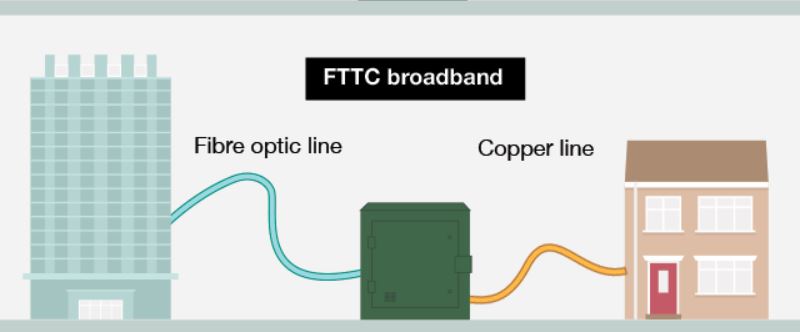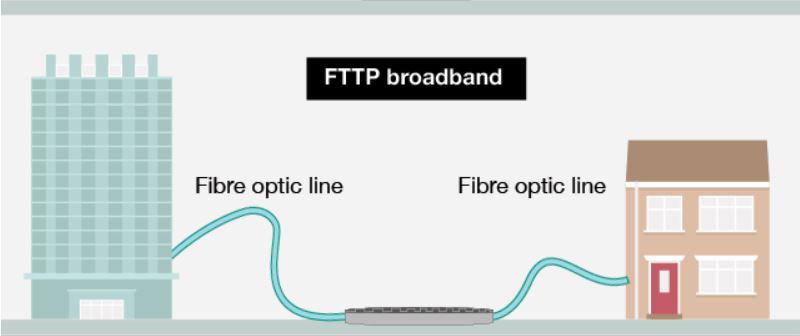
Broadband
With the introduction and accelerated advancement of technologies, having access to affordable and reliable high speed broadband is quickly becoming a critical infrastructure and utility, just like electricity and water.
Some communities in Ceredigion find they are lacking adequate broadband services, creating a “digital divide” among those with access and those without. This is largely due to rural areas being more expansive and difficult to provide advanced broadband networks.
Ceredigion County Council aim to solve this problem by supporting both Government funded and privately funding projects across the County. Ensuring that as many people as possible have access to high speed broadband to support both the lives of residents and the Counties economy.
How to improve your broadband connection
1: Find out what speeds you currently receive
You can run a speed test, or use Ofcom’s official mobile and broadband checker, this will tell you what speed you are currently receiving.
2: Find out what broadband service can you already receive
Check if you currently receive a FTTC (fibre to the cabinet) or a FTTP (fibre to the premises) connection via the Openreach Fibre Checker. You may already be able to receive faster broadband, but may not be aware of this. If you have access to fibre broadband, discuss with an Internet Service Provider (ISP) what packages may be available to improve your speed.
3: Assess your options
If you are unable to receive Superfast Broadband through a fibre network, there may be alternative technologies to enable you to receive superfast speeds. These include – a fixed wireless connection, a mobile/4G router or a satellite connection. For further information regarding alternatives technologies, visit the Alternative broadband technologies page on the Welsh Government website.
You can also find out if your property is included in future fibre roll-out plans by visiting the Find out how to get faster broadband page on the Welsh Government website. All you need to do is enter your postcode and to find your address in the drop down menu.
Available Funding to Improve your Broadband
There are a number of Government funded schemes available for businesses and residents interested in improving their current broadband speeds.
Funding schemes available for those that are not due to be covered in the superfast rollout or commercial plans currently include:
The UK Gigabit Voucher will provide grants of up to £1,500 for households and up to£3,500 for businesses in the hardest to reach rural areas to support the cost of installing new gigabit-capable connections when part of a group scheme.
Home and businesses in rural locations which meet the following criteria can use vouchers to support the cost of installing new gigabit-capable connections when part of a group project.
- Existing broadband speeds are less than 100Mbps
- A gigabit capable network isn’t likely to be built in that area commercially
- There is no government-funded contract planned or in place to improve the network
You can check whether your home or business is eligible on the Get a voucher page with further details on the scheme available at the UK Governments Gigabit Voucher Scheme website.
Openreach work with local communities to build a customised fibre solution to bring fibre broadband to homes and businesses.
Openreach put a joint funding arrangement in place, which means they contribute some of the costs and the community funds the rest, which is usually covered through the Gigabit Voucher Scheme. Openreach will then build the most affordable solution to meet your needs. Openreach will advise on any grants you might be able to receive to support the project.
Details can be found on Openreach's Community Fibre Partnerships website.
This scheme provides grants to fund (or part-fund) the installation costs of new broadband connections for homes and businesses in Wales. It does not include monthly rental costs.
New connections through this scheme must deliver a step change in speed - with at least double your current download speeds eg a current connection of 10Mbps must improve to at least 20Mbps.
The amount of funding you can receive depends on the speed of the new connection:
- £400 for 10Mbps and above
- £800 for 30Mbps and above
Further details and how to register your interest can be found on the Access Broadband Cymru grant scheme page on the Welsh Governments website.
If you can’t receive a download speed of 10 Mbit/s and an upload speed of 1 Mbit/s, you can request an upgraded connection. You can make this request to BT, who will cover up to £3,400 for the cost of this connection. You do not need to be an existing customer of BT apply.
Further details regarding the Universal Service Obligation can be found on the Ofcom website and the BT website.
The Superfast Cymru programme is a Welsh Government programme aimed at deploying Superfast Broadband to homes and businesses in Wales. Further details and to check if your property is included within the programme, please visit the Find out how to get faster broadband page on the Welsh Government website.
More than one million hard to reach homes and businesses will have next generation gigabit broadband built to them in the first phase of a £5 billion government infrastructure project. Further details upon the project can be found upon the UK Government's website.
FAQ
Below is a list of frequently asked question that will hopefully provide a better understanding of what broadband is, what different types of connections mean and how different speeds can have an effect on your connectivity.
Broadband is a high-speed internet connection that allows you to enjoy everything that the online world has to offer.
Before broadband, internet access was achieved with 'narrowband' dial up connections that were very slow by todays standards. Broadband is much quicker and can be considered as always on, removing the need to 'dial up' every time you need to access the internet.
Fibre broadband is a type of high-speed broadband. It uses fibre optic cables, which are better at transferring data than standard copper cables, making it faster and more reliable than other forms of broadband. Fibre broadband is important as the demand and need for streaming TV, movies and online gaming increases, as well on a greater shift towards working from home.
Fibre broadband can be delivered in two ways: Fibre to the Cabinet (FTTC) and Fibre to the Premises (FTTP).
Superfast broadband is defined as a download speed of at least 30Mbps by the UK Telecoms regulator Ofcom.
Ultrafast broadband refers to download speeds in excess of 100Mbps.
Standard – 10Mbps: Broadband basics: news, keeping in touch with family and friends, some online shopping.
Superfast – in excess of 30Mbps: Broadband basics + watching tv and films, and listening to music without interruption.
Ultrafast – in excess of 100mbps and up to 300mbps: Multiple devices at the same time – working, streaming, gaming, video-calling or uploading.
Gigabit broadband – 1000mbps: An internet connection that offers a speed of 1 gigabit per second (1gbps)
FTTC and FTTP are the two main types of fibre broadband available in the UK.
These two acronyms define how much fibre optic cable is being used in a connection.
FTTC uses fibre-optic cable from the exchange to the street cabinet. Existing copper phone wires are then used to connect the cabinet to a property. FTTC generally provides a maximum download speed of up to 80Mbps. These speeds decrease as the length of the copper cable increases and the further the property is from the exchange or cabinet.

FTTP stands for Fibre to the Premises, which means the fibre optic cable reaches all the way to your home or business instead of just to the cabinet. This means that no copper telephone lines are being used anywhere in the connection, making for significantly faster internet speed.

Many websites allow you to check your current download and upload speeds.
Here are some links:
Speeds can vary at different times of the day depending on your broadband connection so it is recommended to test at different times.
Following the steps above can be of great assistance in understanding the current connection and services that are available to you. Details are also provided upon possible funding that may be available to improve your connection.
Follow Ofcom's top tips and advice on how you can improve your broadband speed at home.
There are also helpful tips at the Increase Broadband Speed website.
There are a number of reasons you may not be able to upgrade to fibre broadband. Some premises may be too far away from the fibre cabinet they are served by to receive superfast speeds, or may be directly connected to the Exchange on copper lines, so cannot upgrade to fibre broadband at present.
High demand for fibre broadband also means some fibre cabinets get full up and need extra capacity adding before more people can place orders. It is possible to receive updates on when fibre will become available to you by entering your details into the Openreach Fibre Checker website.
Take time to explore your options and choose the right deal for you. When comparing packages it is important to consider the following:
Price - Price comparison websites can be helpful to find the best deal for you. It is suggested to use a comparison website such as Ofcom or thinkbroadband.com.
Speed - This should be checked carefully as some broadband packages can restrict your download/upload speeds in return for a cheaper tariff.
Usage - Some tariffs will dictate the maximum limit of downloads/uploads per month whereas some packages will provide unlimited usage with no limits.
Contract - Check the contract length you are being offered. It is important to take note of the time you will be entering a contract for. Typically, it will be 12 or 18 months.
Calls -Many providers will offer a combined package which provides a telephone service alongside your broadband connection. You may be able to save money this way. TV services are another aspect commonly bundled in packages.
Special offers - these could be things like introductory offers & bundled services.
You can do this by visiting the Find out how to get faster broadband page on the Welsh Government website. All you need to do is enter your postcode and to find your address in the drop down menu.
The Council can not provide advice upon which Internet Service Provider may be best for you.
Price comparison websites can be helpful to find the best deal for you. It is suggested to use a comparison website such as Ofcom or thinkbroadband.com.
If you can’t find the information you are looking for on this website, please contact digidol@ceredigion.gov.uk, including your address, to help us deal with your enquiry.
